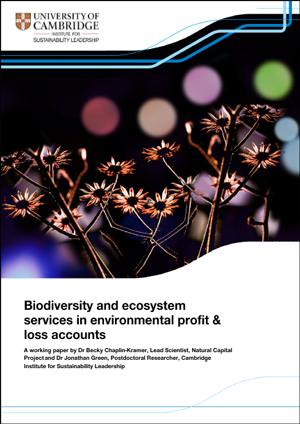October 2016 – This paper is a unique collaboration between the Cambridge Institute for Sustainability Leadership (CISL), Kering, a world leader in apparel and accessories, and the Stanford Woods Institute for the Environment working with the Natural Capital Project. This paper explores how improved biodiversity metrics and methodologies can be developed, tested and then deployed to help businesses factor biodiversity into their decision-making processes.
 Publication date
Publication date
October 2016
Abstract
The Environmental Profit & Loss (EP&L) methodology, a pioneering corporate natural capital accounting methodology, was developed at Kering to help corporate decision-makers understand environmental impacts in their business and supply chains. Several companies are now mainstreaming the EP&L as an internal decision-making tool, and it is included as a methodology within the Natural Capital Protocol (NCC 2016). Kering is committed to continuous improvement on the EP&L methodology and as such has focused efforts on how to better represent impacts on of biodiversity and ecosystem services at the base of the supply chain where raw materials are produced and sourced. This report provides recommendations and examples of how the EP&L can be adapted into a more flexible and cutting-edge tool, but the findings are more generally relevant for measurement of a company’s impacts on natural capital, whether through an accounting-based framework or not.
The first set of recommendations are aimed at enhancing the current EP&L approach, through spatial, predictive modelling for ecosystem services and utilising a growing platform of global data and models on natural capital. Our proof-of-concept analyses have shown that current EP&L assessments may be underestimating the impacts of agricultural management on biodiversity and ecosystem services by 2–5 times. The second set of recommendations involves aspects of biodiversity that are currently missing in the EP&L, and the consideration of an additional indicator for biodiversity that can sit alongside. Together, these recommendations provide scope for work that will allow the EP&L and accompanying indicators the flexibility to explore new management scenarios and test possibilities for companies to have positive impact in the production process.
This working paper complements the business report Biodiversity and ecosystem services in corporate natural capital accounting.
Authors
Dr Becky Chaplin-Kramer, Lead Scientist, Natural Capital Project and Dr Jonathan Green, Postdoctoral Researcher, CISL
Citation
Chaplin-Kramer, B. & Green, J., (2016), ‘Biodiversity and ecosystem services in environmental profit & loss accounts’, University of Cambridge Institute for Sustainability Leadership (CISL), Working Paper 05/2016



